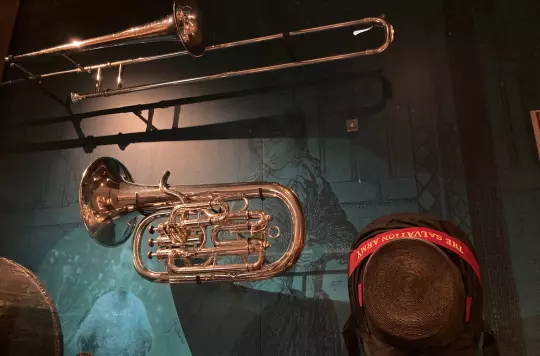Salvation Army’s origin story told as new faith museum opens
published on 11 Oct 2023

A new museum exploring 6,000 years of faith in Britain features the origin story of The Salvation Army with a tenor horn and trombone making up part of its collection.
The Faith Museum in Bishop Auckland, County Durham, which opened this month, aims to explore the ways faith has shaped lives and communities across Britain through rarely seen objects, treasures and testimonies.
The Salvation Army has donated a 1905 tenor horn, a song book, a bonnet and porcelain cup from the early 1900s, and a print of the ‘Salvation Army Social Campaign’ image from founder William Booth’s book In Darkest England and the Way Out, for part of the exhibition focused on faith and charity.

Steven Spencer, Director of The Salvation Army’s International Heritage Centre, said: “It was a great privilege to be able to share some objects with the Faith Museum from our own collection, which tells the story of The Salvation Army from its origins in the East End of London in 1865 to the international church and charity it is today.
“Our founders William and Catherine Booth had a vision of taking God’s word directly to the people and supporting the most vulnerable and marginalised, which as a Christian organisation we continue to do.”
The exhibition tells of the ‘soup, soap and salvation’ origins of the church and charity explaining William and Catherine’s aim to ‘save souls and help those in need’ by running soup kitchens, shelters and women’s refuges.

Steven continued: “We thought carefully about what items really represent The Salvation Army and its history. The items chosen will be recognisable to people and we hope will help evoke their own memories of The Salvation Army, whether that’s through a personal connection or fond memories of seeing the band playing in town centres at Christmas.
“The museum looks wonderful. It tells a complex and diverse story with ease and grace. There are some spectacular loan items from other national collections and it’s fantastic to have our story represented in this new museum as part of the rich history of faith in this country.”

The museum, which is part of the Auckland Project, a group of heritage attractions in the historic town of Bishop Auckland founded by resident Jonathan Ruffer, includes the Gainford Stone (around 4,000-2,500 BC), a rare early example of Christianity in the Binchester Ring, excavated in 2014 at the nearby Roman Fort Vinovium, a 13th century Bodleian Bowl which is an early example of evidence of Jewish communities in Britain, a copy of William Tyndale’s English translation of the New Testament from 1536 and a set of 20th-century prayer beads owned by Lord Headley believed to be the first Briton to have legitimately completed the Hajj pilgrimage to Mecca, having converted to Islam.
There are also exhibitions by contemporary artists exploring what faith means today, including an immersive installation by Mat Collishaw.
Jonathan Ruffer, Founder of The Auckland Project, said: "The Faith Museum turned out to be the hardest piece of our jigsaw. We have tried to tell stories which put into context 6,000 years of human endeavour and the restlessness of the human spirit.”
